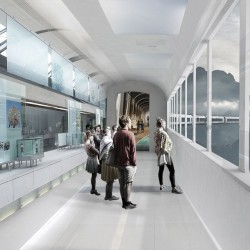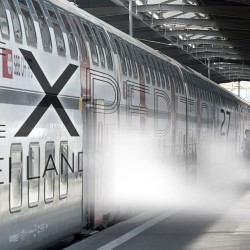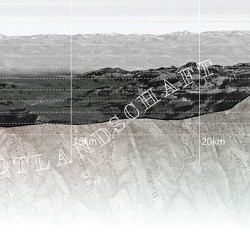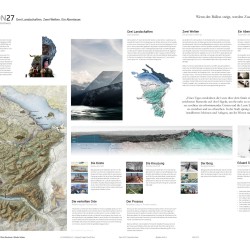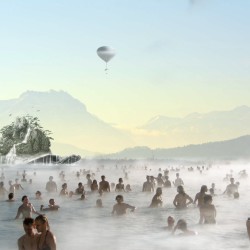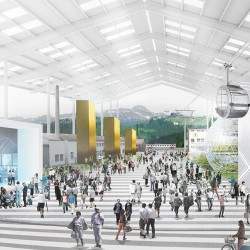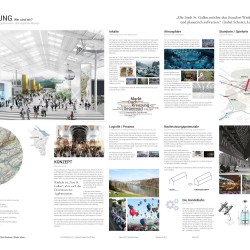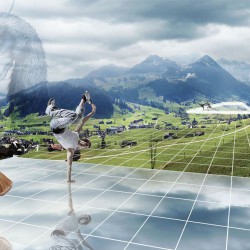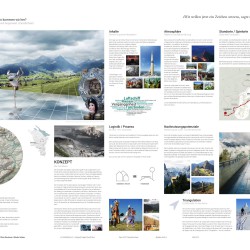Hosoya Schaefer Architects . Plinio Bachmann . Studio Vulkan Landschaftsarchitektur
As a confederation based on common sense more than on common history, Switzerland uses its national exhibitions, the “expos“, as platforms to regularly refresh its national narrative. Earlier expos revolved around identity and national defense (1939), progress and innovation (1964) or creativity and the arts (2002). The Expo27 will focus on our lives and living environment (“Lebensraum”): It will look at landscape, space and resources, and the challenge to develop ideas, institutions and infrastructures necessary for their long-term, collective use.
The landscape is stage and scenery, topic and territory for our research journey, the Expedition27. Instead of locating themes on designated fair grounds this expo looks for themes on location. The idyllic landscape of Eastern Switzerland is as full of history, technology and stories as it is of nature. As a microcosm of our earth bound human existence it talks of the past and the future, of the archaic (“wüescht”) and the civilized (“schön”). The Expo27 offers new perspectives and establishes meaningful connections. As an extraordinary event it allows for mobilization beyond the ordinary rules, regulations and roadblocks to collectively develop this landscape further and fill it with new stories.
The expo territory is divided into three large zones. The mountain landscape with its vast views and green hills of the Appenzell, the urban landscape with the agglomeration St. Gallen, the agricultural land of the Thurgau and the Rhine valley and the lake landscape with the openness and internationality of the shores of lake Konstanz. The expo structures the three main questions “Where do we come from?”, “Where are we now?” and “Where are we going?” in resonance with this geography.
Three railway rings form the logistical backbone of the expo and act as its main means of transport: The costal-line, the mountain-line and the urban-line. The three lines cross paths at the central intersection in Winkeln. A specially designed train schedule and routing plan makes use of excess capacity in existing schedules, services temporary stations and works with decommissioned train compositions. Together with additional elements of public transport it serves also small and very small expo locations.
All of this is connected in an overarching story that consists of a narrative web of old myths, contemporary tales and future scenarios. These stories guide visitors on their adventures through the expo landscape, frame new perspectives and enrich the day-to-day reality with a second layer of narration – contemplating it, interpreting it and spinning it further. Infrastructure ties this web together. Accessibility replaces density and collective experience the theme park, as in a time of ever increasing virtualisation and ubiquity of information movement in space, personal experience and the serendipity of the real remain necessarily physical.
The visitors experience the varying narrative strands of the expo either alone or in carefully curated fellowships. Individual and collective adventures bring the landscape to life and make it real.
The Expo27, therefore, will be the Expedition27 – three landscapes, two worlds, one adventure!
PROJECT:
Expo 2027
YEAR:
2015 –
CLIENT:
Cantons Appenzell Ausserrhoden, St. Gallen and Thurgau
LOCATION:
Bodensee – Eastern Switzerland
PROGRAM:
Concept for the Swiss Expo 2027
COMMISSION:
International competition: 1st prize.
CO-AUTHOR / ARCHITECT:
Hosoya Schaefer Architects, Zurich
CO-AUTHOR / SCRIPT WRITER:
Plinio Bachmann
CO-AUTHOR / LANDSCAPE ARCHITECT:
Studio Vulkan Landschaftsarchitektur GmbH, Zurich
COLLABORATORS:
Emch + Berger, Zurich; Integral Ruedi Baur, Zurich; KEEAS Raumkonzepte, Zurich
Expedition 27:
Three Landscapes. Two Worlds. One Adventure.


